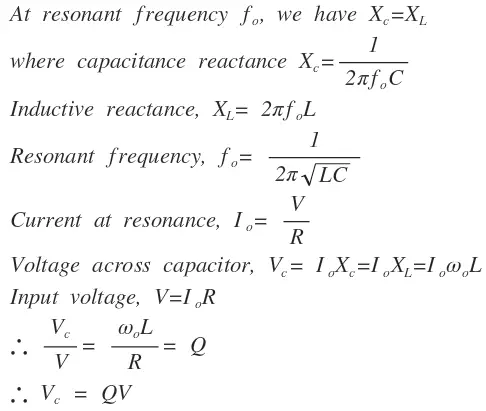Q-meter is an instrument designed for measuring Quality factor (Q) of a coil as well as for the measurement of inductance, capacitance, and resistance of an electric circuit at radio-frequency. Q-meter is also known as RLC meter.
What is Quality factor of the coil?
The ratio of the inductive reactance to the effective resistance of the coil is called the Quality factor of the coil. It is denoted by Q.

Circuit Diagram of Q-meter
The Q-meter operates on the principle of series resonance i.e. under the resonant condition of an AC series circuit voltage across the capacitor is equal to the applied voltage times of Quality factor of the circuit. If the applied voltage across the circuit is kept-constant then voltmeter connected across the capacitor can be calibrated to indicate Quality factor value directly.

The practical circuit for measurement of Quality factor shown in Figure 1. The oscillator is set to the desired frequency and then the tuning capacitor (C) is adjusted for maximum value Vc. The input voltage V is kept constant then the voltage across the capacitor (Vc) is calibrated to read the value of Quality factor value directly. The measured value of Quality factor value is defined for the whole circuit, not of the coil alone. There are the errors caused due to shunt resistance and distributed capacitance of the circuit.

Correction for shunt resistance


Correction for distributed capacitance

where, Cd = distributed capacitor
C = tuning capacitance
Measurement of self Capacitance
The value of inductance is given by

the values of f0 and C are known and therefore the value of inductance may be calculated.
Measurement of Effective Resistance
The value of effective resistance may be computed from the relation

Measurement of Self-Capacitance
The self-capacitance of the coil is measured by making two measurements at different frequencies. The capacitor is set to a high value and the circuit is resonated by adjustment of the oscillator frequency. The Resonance is indicated by the circuit Q-meter. Let the value of the tuning capacitor be C1 and that of frequency be f1 under this condition. Therefore,

The frequency is now increased to twice its initial value and the circuit is resonated again this time with the help of the tuning capacitor. Let the values of the tuning capacitor be C2 and that of frequency be f2 under this condition. Therefore,

Now, f2=2*f1
Then distributed capacitance, Cd is given by

Applications of Q-Meter
The Q-meter can be used for many purposes.
- As the name implies, it can measure Quality factor and is generally used to check the Quality factor of inductors.
- It is used to measure self-capacitance of the coil.
- The characteristic impedance of a transmission line can be measured using the series substitution method.
- It is used for the measurement of bandwidth.
- Q-meter is used for the measurement of capacitance. The capacitor sample is resonated with a selected inductor by adjusting the source frequency and by using the tuning capacitor set to a low value on its calibrated scale.
Questions & Answers
Q1. On what principle does a Q-meter operate?
Answer. The Q-meter operates on the principle of series resonance i.e., under a resonant condition of an ac series circuit voltage across the capacitor is equal to the applied voltage times of Q of the circuit.
Q2. What are the different parameters that can be measured using a Q-meter?
Answer. The Q-meter is used for measuring Q-factor, inductance, effective resistance, self-capacitance, bandwidth and capacitance.
Q3. Why the actual Q-factor of the coil is somewhat larger than the calculated Q-factor?
Answer. The calculated value of Q-factor is somewhat smaller than its actual value because Q-factor measurement includes the losses of the resonating capacitor, voltmeter and the shunt resistance Rsh.
Q4. What is Q-factor of the coil?
Answer. The ratio of the inductive reactance to the effective resistance of the coil is called the Q-factor of the coil.
Q5. What is Q-meter?
Answer. The Q-meter is an instrument designed for measurement of Q-factor of a coil as well as for the measurement of electrical properties of coils and capacitors.
Q6. What are the factors which affect the measurement accuracy of Q-meter?
Answer. The factors affecting measurement accuracy are
- Distributed capacitance or self-capacitance of the coil
- Residual inductance of the instrument
- Conductance of voltmeter
- Shunt resistor of Q-meter

it is very useful content…………. thank you guys